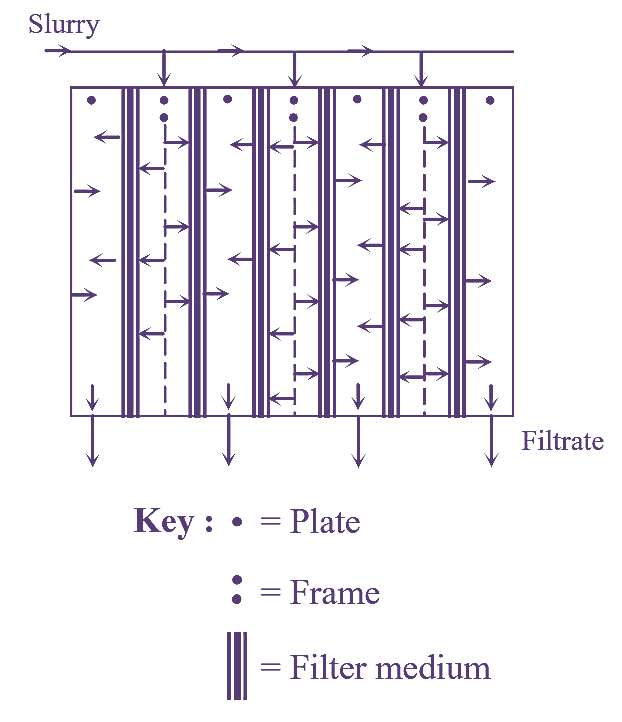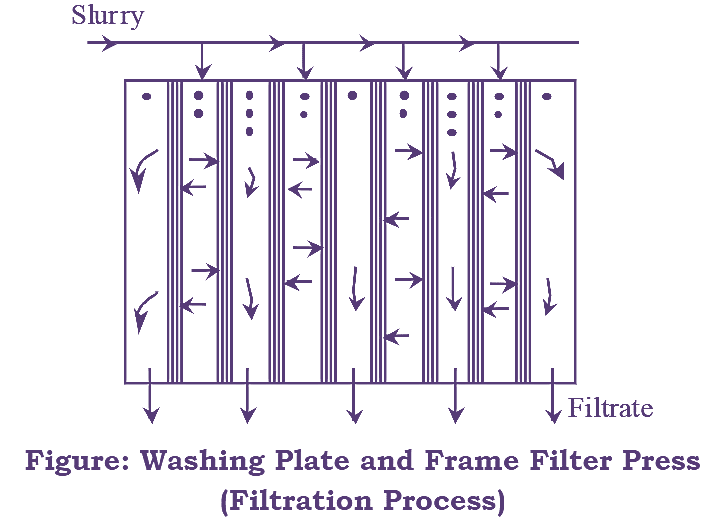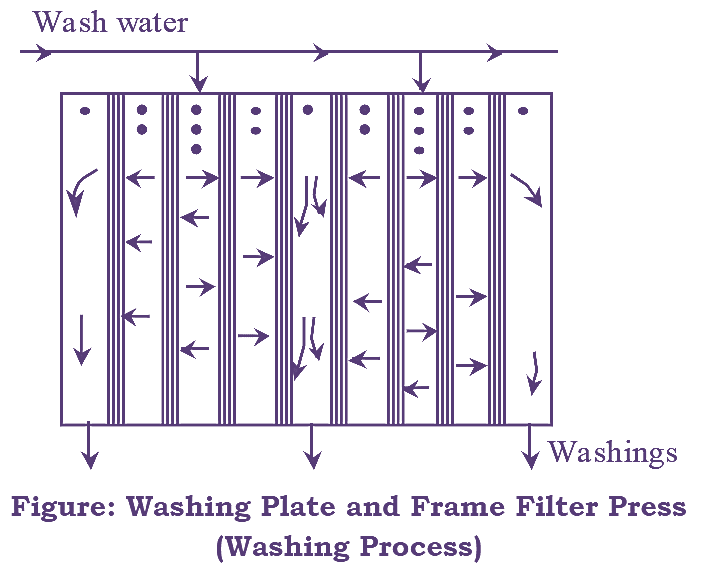
Figure 1: Plate and Frame Filter Press.
Working Principle of Plate and Frame Filter Press
Plate and frame filter press functions based on the surface filtration mechanism. The slurry to be filtered is pumped under pressure into the plate and filter press following which the panicles are retained on the filter medium, while the filtrate is collected at the outlet.
Construction and Working of Plate and Frame Filter Press
- As the name implies, this filter is made up of two types of units, known as plates and frames. It has a filter medium (filter cloth) arranged in between.
- Frame contains a space where the slurry reservoir is held. It also contains an inlet for the slurry which is represented by two dots. The plate has a studded or grooved surface to support the filter cloth and has an outlet for the filtrate. It is represented by one dot.
- As the feed is introduced in the feed reservoir, it enters the frame. Solids present in the feed form a filter cake in the frame, while the liquid is filtered through the filter medium and enters the surface of the plate.
- The filtrate drains down the plate and is collected at the outlet. When the frame get filled with the filter cake, the filtration is completed. This filter cake is removed and the next cycle of filtration is staffed.
- In pharmaceutical industries, a series of plate and frames are arranged with filter medium in between so that a large surface area is achieved for filtration.
- The plates and frames are arranged as follows: Plate, filter medium, frame, filter medium, plate which are represented by 1.2.1 and so on. The inlets of frame and outlets of plates are so arranged that a channel is formed. In some of the plate and frame filter press, the inlet channel is made in this way and the individual outlets of the plates are controlled by valves.
- It has an advantage that if the filter medium is destroyed, the plate is removed and the process can be continued with one plate less.
- In order to avoid contamination, each plate is provided with an outlet from where the filtrate drains through a glass tube, then through a control valve to an enclosed outlet. This allows the inspection of the filtrate.
- The thickness of the filter cake depends on the thickness of the frame used.
- The filter cake obtained must have an optimum thickness, based on the quantity of solids in the slurry and the resistance offered by the filter cake. As the filtration proceeds, thickness of the filter cake formed is increased and hence the rate of filtration is decreased.
- A point is reached where the filtration comes to a standstill. This is because the frame has now been filled completely with the filter cake. Hence, this filter cake formed offers resistance to the flow of the feed.
- The thickness of the filter cake is half the thickness of the frame. This is because the deposition of cake is on both the sides of the frame. Hence, these two cakes meet at the centre of the frame.
- For filtration of viscous slurries, the plates are provided with heating and cooling coils.
- The plates and frames are available in different metals, non-metals and reinforced plastics.
- Non-metals are corrosion-free and contamination free. The reinforced plastic has an advantage of being light weight.
Washing of the Filter Cake
- With an ordinary plate and frame press, the washing of filter cake is not satisfactory.
- Therefore, modified plate and frame press is used i.e., special plates and frames are used with a separate channel to drain the wash water.
- The slurry inlet and filtrate outlet are similar to the ordinary plate and frame press.
- 50% of the plates are special plates, where the wash water channel is connected to their surfaces. These plates are represented by three dots.
- Alternately, two types of plates are used with frames between each plate. The arrangement is represented as 1.2.3, 2.1.2, 3.2.1, 2.3.2.1, etc.

- When the filtration is complete with the frames filled with the filter cakes, the cake is washed as follows.

First, the outlets of the washing plates are closed. Now the wash water is introduced into the washing channel. This wash water enters the surface of the washing plates (three dots) passes through the filter cloth and comes back to the same washing plate from behind. The wash water then enters the filter cake present on the adjacent frames (two dots), and finally through the filter cloth enters the ordinary plate (one dot). It then drains down the surface of the plate finally leaving the plate from the outlet. With this method, the washing is more efficient than with the ordinary press because the resistance to the flow offered by the cake is equal at all points. Hence, the entire cake is washed efficiently due to the flow of water on the entire surface of special washing plates.
Advantages of Plate and Frame Filter Press
- Filter press is simple in construction and is available in wide range of materials.
- The capacity is variable according to number of plates/ frames.
- Because of the sturdy construction, considerable pressure difference up to 20 bars is permissible.
- All joints are external and leakage is readily detected.
- Filter cloths can be readily replaceable. Provides a large filtering area in a small floor space.
- Washing of the cake is efficient.
Disadvantages of Plate and Frame Filter Press
- Due to frequent dismantling, the wear on the cloth is high.
- As the labour costs are high, the machine is preferable for the filtration of expensive materials like collection of bismuth salts and precipitated proteins.
- This is done so that the high labour cost compensate the filtration of expensive materials.
- The frame must be completely filled with the filter cake, otherwise the washing is inefficient. Hence, its operation is critical.
- It is a batch filter.
Applications of Plate and Frame Filter Press
- Collection of the precipitated antitoxins.
- Removal of unwanted proteins from insulin liquors.
- Removal of cell broth from the medium of fermentation.
- Sterilization of the equipment is possible.
- Retention of bacteria is possible by the asbestos and cellulose filter sheets.